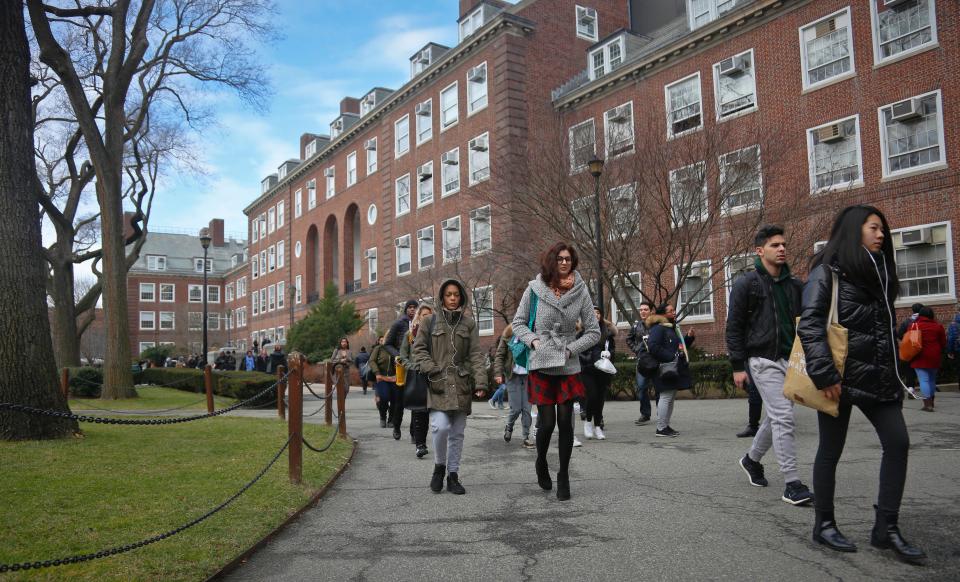Democrats' 'free college' plans are simplistic and unfair. How about some realism?
Democrats should not let “free college” or “no debt” become litmus tests of progressive virtue in the 2020 election cycle. Too much is at stake. There are alternative policy ideas that are more equitable, more cost effective and more likely to pass in a polarized and divided Congress.
With the average amount borrowed by bachelor’s degree recipients at public universities rising from $21,600 in 2001 to $26,900 in 2017, measured in 2017 dollars, tuition-free college is compelling in its simplicity. The bumper-sticker message sends a signal to low-income families and first-generation students unfamiliar with the financial aid process that achieving a post-secondary credential is possible.
Republicans and Democrats alike want a higher education system that acts as an engine of social mobility. To achieve that, we need targeted programs that improve access and success. Because a Mitch McConnell-led Senate isn’t likely to take up the cause of free college, and even a slim Democratic Senate majority might not go for it in 2021, a good set of programs also needs to be politically feasible in a world of limited resources.
4 ideas that could become reality
Here are four suggestions for Congress based on those criteria:
►Increase the maximum Federal Pell Grant 50% (roughly $3,000), and couple the increase with reasonable restrictions on the amount of federal money that can be used for nontuition expenses.
►Partner with states by offering a federal block grant for higher education if states appropriate at least a certain dollar amount per full-time student (perhaps $3,000), and increase the grant per student as states spend more, up to some limit.

►Offer nonprofit colleges and universities that work with significant numbers of lower-income students a small operating subsidy equal to a percentage of the Pell dollars their students receive.
►Tie any additional grant subsidies and student loan interest rates to accountability measures such as graduation rates and gainful employment for students upon graduation.
Make Pell grants bigger and better
The Pell grant is targeted at those who need it the most, so increasing the maximum grant would improve access to higher education at a much lower cost to taxpayers than making college tuition-free. It is also portable, so the program would not discriminate against the large number of private colleges that are excellent matches for millions of lower-income students. Enlarging the Pell maximum would allow more families in the middle of the income distribution to qualify.
Bernie Sanders: Free Americans by canceling $1.6 trillion in student loan debt
A federal-state partnership proposal would reward states that behave well, and give a financial incentive to states that push more of the cost of attendance onto families. In 2014, then-Sen. Tom Harkin, D-Iowa, offered a partnership proposal that is well worth a second look.
We know that resources matter for retention and graduation, so putting more resources into the nonprofit colleges that work extensively with low-income students may significantly reduce the cost to students and to society for each degree earned.
Don't reward colleges that fail
Strengthening the federal government’s response to bad actors in higher education can only increase accountability and improve student outcomes. By restricting student financial aid at institutions with low graduation rates and abysmal records of ensuring their students receive gainful employment upon graduation, we can encourage more students to attend the colleges and universities most likely to help them graduate and avoid crippling debt.
Throw money, raise costs: Sen. Elizabeth Warren's college plan flunks fiscal and fairness tests
Complex policy problems deserve nuanced solutions. While free college has its benefits, its simplicity makes it a regressive policy that will most help the wealthy. Our alternative set of policy proposals certainly has more moving parts. Yet those pieces together answer the fundamental issues limiting college affordability in a more efficient and progressive manner than free college. We can do better than a bumper sticker, and we must.
David H. Feldman, an economics professor at the College of William & Mary, is co-author of “Why does College Cost So Much?” and “The Road Ahead for America’s Colleges and Universities.” Christopher R. Marsicano, a visiting assistant professor of educational studies at Davidson College, specializes in higher education finance and policy. Follow them on Twitter: @dhfeld1 and @ChrisMarsicano
You can read diverse opinions from our Board of Contributors and other writers on the Opinion front page, on Twitter @usatodayopinion and in our daily Opinion newsletter. To respond to a column, submit a comment to letters@usatoday.com.
This article originally appeared on USA TODAY: Free college, no debt? Get practical if you want to help students.

